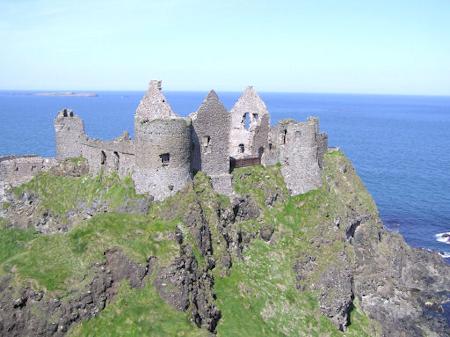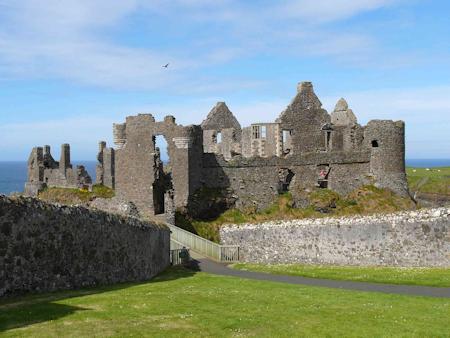
Dunluce Castle
Dunluce is one of Ireland's most spectacularly sited castles. The castle is perched on a rock connected to the mainland by a modern wooden bridge (in place of the original drawbridge) with scenic white cliffs to the west and the Giant's Causeway to the east.
Little is known about the early history of the castle. The Gaelic word 'Dun' in the name suggests that there may have been an early fortification here and parts of the castle seem to date back to the 14th Century, but most of the buildings are believed to date from the 16th and 17th Centuries.
The Norman castle buildings were begun by Richard de Burgo, Earl of Ulster, in the late 13th Century. The main part of the castle is of a much later date and the castle is first documented as being in the hands of the McQuillan family in 1513. The McQillans were displaced by the MacDonalds in the mid-to-late 16th Century.
The MacDonald Clan
The MacDonalds were known as the "Lords of the Isles" and ruled across vast estates in Scotland. Dunluce Castle was the stronghold of Sorley Boy MacDonald who lost the castle twice. Once to Shane O'Neill, with whom he was in regular conflict and again in 1584 to Sir John Perrot, Elizabeth I's deputy in Ireland.
Sorley Boy presented ongoing strategic problems to the governments of both Scotland and Ireland. He also assisted with the escape of survivors from the Spanish Armada. The ship Girona ran aground here in 1588 and he helped transport the survivors to Scotland. The cannon from the ship were mounted on gun ports on the curtain wall and the treasure he took from the ship was used to repair and upgrade the castle.
The castle reached its height in the 1600s under Randal MacDonald 2nd Earl of Antrim and 1st Marquiss of Antrim (Sorley Boy's grandson). He married the wealthy Katherine Manners, widow of the 1st Duke of Buckingham. With her fortune he laid out the castle with all the trappings of a rich and powerful aristocratic family. There are accounts of tapestries, mirrors and rich furnishings.
Decline of the Castle
In 1639 part of the castle's yard fell into the sea, reputedly taking a number of the household with it.
Following the Battle of the Boyne in 1690 the MacDonalds of Antrim were impoverished and the castle was abandoned and left to fall into ruin. It did, however, remain in the hands of the Earls of Antrim until 1928.
In modern times the castle's dramatic appearance and superb location have seen it appear on a couple of album sleeves, including Led Zepplin's Houses of the Holy. The castle was also used in the 2003 film The Medallion, under the fictional name "Raven's Keep", as a setting for the bad guy's hideout.
Today the castle is owned by Northern Ireland Environment Agency and run as a visitor attraction and historic monument. The grounds include a visitor's centre with toilets and a shop, parking and a picnic area. Access to the castle is allowed, but restricted for safety and historical layout reasons.
Status: Ruin
Owner: Northern Ireland Enivonment Agency
Tel: 028 2073 1938
Website: http://www.doeni.gov.uk/niea/dunluce.htm
Opening Times: 10am to 4pm daily


Dunluce Castle, viewed across the cliffs.

Entrance to Dunluce Castle.